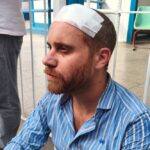
Bombs have fallen again on the Gaza Strip since early Friday. Men have not been able to enjoy another Friday of calm, in which to go to the mosque on their holy day, nor have children been able to play in the street, nor have women been able to go to the market without worrying about being the target of an Israeli attack or a ‘collateral damage’ of this war that has left more than 15,000 victims – including more than 6,000 children –, nearly 80% of the population displaced and some 300,000 homes completely destroyed or damaged.
The injured have returned by the dozens to hospitals that are either out of service or operating at the limit of their capacities due to a lack of medical supplies and personnel, and fuel for electrical generators. According to the Gaza Health Ministry, more than 200 Palestinians have died in 24 hours since the humanitarian pause ended.
The World Health Organization (WHO) has warned that hospitals are overwhelmed and the few that continue to operate cannot stop doing so: “The health system in Gaza cannot afford to lose one more hospital or any hospital beds. “We are very concerned about the resumption of violence that could destroy health facilities, as happened in the north” of Gaza, admitted the WHO representative in the occupied Palestinian territories, Richard Peeperkorn. In a press conference in Geneva, he explained that in the northern part of the Strip there are only three small hospitals that are barely functioning, while in the south of the Strip they are completely saturated. “It’s like a horror movie, when you walk in [en un hospital] There are patients on the ground with the most serious injuries you can imagine, basically war wounds (…) Many of the workers have fled with their families or have been killed. “The supplies are not enough,” described a WHO Emergency Representative, Rob Holden, from Gaza.
Also from a hospital in the Palestinian enclave, the spokesman for the UN Children’s Fund (UNICEF), James Elder, has appealed to “those who have influence.” In a video posted on his X account (formerly Twitter), Elder shows a little boy lying motionless on a bed: “This is Ahmed, he is three years old. His favorite sport is soccer. Ahmed’s right foot was amputated by the destruction of his house, where members of his family were murdered a few weeks ago. The bombing has started again now. We cannot allow this war on children to continue. “We cannot allow more children in Gaza to suffer like Ahmed.”
On behalf of 3yr old Ahmed, I say to those with influence > Please find your empathy. Your compassion?!
It’s dismaying to hear how so many overlook the horrors hitting children in #Gaza Get those Israeli children home; & stop killing thousands in Gaza. Please. Stop. pic.twitter.com/Wj9KyU0TmW— James Elder (@1james_elder) December 1, 2023
“Today, those in power have decided to resume the killing of children in Gaza,” he denounced in a statement. “It is deeply disturbing to hear how some have been able to overlook the tragic death of these children and now, today, they seem to feel comfortable with the horrors – the attacks – beginning again,” he lamented and asked to stop this “tragedy.” totally avoidable.”
More than a hundred dead in a few hours
However, the reality on the ground indicates the opposite. The Israeli Army has announced that, since the end of the truce at 07:00 local time (06:00 in Spain) on Friday, it has attacked some “200 terrorist targets” of Hamas in the Strip, where they died in less than twelve hours. 110 people, according to data from the Gazan Government, controlled by the Islamist group. Among those killed on Friday are three Palestinian journalists, the only ones who can report on what is happening inside Gaza.
“With the continuation of the Israeli Army’s war of extermination against our people in Gaza, life has stopped quickly and completely,” said the spokesman for the local Government Communication Office in a press conference after the fall of the sun. He has also recalled that thousands of bodies remain under the rubble and that rescue teams have not been able to remove them during the truce because the vehicles and machinery that have not been destroyed in Israeli attacks do not have diesel to operate. The fuel tankers that have entered the Strip from Egypt in the past seven days, despite being many more than those that entered before the cessation of hostilities, have not been able to cover the enormous needs of the population and the most important infrastructure. basics such as hospitals and shelters.
The Government of Gaza has also blamed Israel and the international community, “specifically the US Administration”, for the “brutal war launched by the Israeli Army.” Precisely, the US Secretary of State, Antony Blinken, visited Israel this Thursday and met with the so-called war cabinet (formed after the Hamas attack on October 7), which has been interpreted as Washington’s approval of the resumption of military operations and Israel’s plans to extend its offensive to the south.
This Friday, the Israeli Army published a map in which you can see hundreds of small areas into which it has divided the Strip and from which it will order the evacuation of civilians “for their safety if necessary” and has asked the Gazans to be attentive to the information and instructions offered online, ignoring the fact that many do not have an internet connection or electricity, nor a safe place to go.

The US had asked Israel, if it resumed its offensive, to establish a concrete plan to protect Gazans, which would include “the precise designation of areas in central and southern Gaza where civilians can be safe.” However, this formula has not worked before, when Israel designated the territory south of the Gaza Valley as a ‘safe zone’ to which civilians must leave, and continued to attack populations south of that natural border. Their troops are deployed to the north and have established a checkpoint through which they only allow civilians to head south, but not return to the north. During the truce, the incidents that occurred were precisely due to the attempts of northern residents to return to their destroyed or damaged homes, and the soldiers prevented them from doing so and opened fire on several occasions.
Israel points south
The Army said it had attacked this Friday the towns of Rafah and Khan Younis, the two largest in the south and where hundreds of thousands of people had taken refuge in the weeks before the ceasefire, following the instructions of the Israeli military. According to UN figures, 1.8 million people – that is, nearly 80% of the Gazan population – have left their homes since October 7 to date.
A few hours after the truce was broken, military planes dropped leaflets on Khan Younis, warning that it was now considered a “dangerous combat zone.” “You have to evacuate immediately and go to the shelters in the Rafah area,” warned the leaflets written in Arabic.
The organization Doctors Without Borders has assured that “the humanitarian situation in southern Gaza is terrible and insecure.” “The forced displacement of almost the entire population of Gaza to a smaller, more delimited space in the south has caused density to reach completely unsustainable levels,” he added, recalling that before the war the Strip was one of the most densely populated, with 2.3 million inhabitants.
The NGO explained in a statement that “Gaza’s health system is collapsed. The population is forced to live in unsanitary and overcrowded conditions, and many people sleep in the open (…) The lack of space is also problematic because, as happened in the north, hospitals in the south have become refuge for thousands of displaced people. The medical staff working there are exhausted, both physically and mentally.”
MSF is providing support to two hospitals in southern and central Gaza, and two clinics in Khan Younis, with Palestinian staff and an international team that was able to access the Strip on November 14. In one of these clinics, the Mártires clinic (which before the truce attended about 250 consultations a day and now, 1,000 consultations), 50% of the patients are children under five years of age, who suffer from diarrhea, urinary infections and skin diseases, among others. “We are providing mental health support to all people, especially internally displaced people,” says a psychologist with the NGO, Marwa Abu Al Nour. “What I see most among girls and boys are nightmares, enuresis (wetting the bed), anxiety and fear.”

Source: www.eldiario.es

